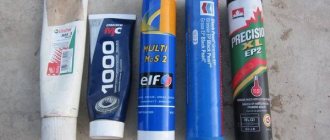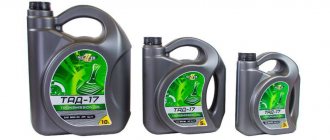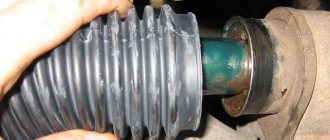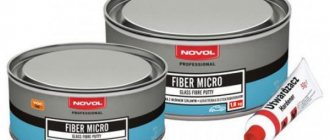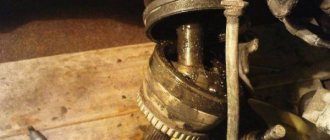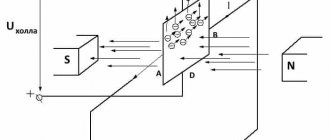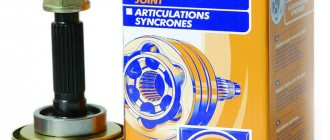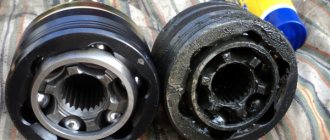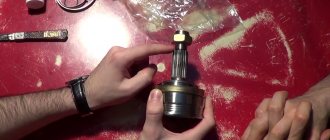A tripod (tripod) CV joint is one of the vehicle mechanisms responsible for transmitting torque from the gearbox to the drive drive (front, less often rear). They ensure uniform rotation of the wheels at angles of rotation up to 70 degrees. These are quite popular mechanisms that are installed on many modern cars.
What is this node? What typical malfunctions occur during operation? Which tripod CV joint lubricant is suitable for servicing the mechanism? Let's look further.
What is a tripod?
The CV joint consists of two autonomous units:
- the internal assembly is attached directly to the drive axle;
- the second is integrated into the drive wheel hub.
They are used to equalize angular velocity with large balls moved along special grooves. Depending on the car model, a specific lubricant is used for the internal CV joint and external analogue. The disadvantage of the mechanical design is that it does not provide for axial movements of the suspension. Needle joints have these properties.
They were called tripods, from the English word tripod. Hinges of this type compensate for the lack of ball analogues. The angular velocity is equalized due to the movement of the rollers along special channels during turns or axial instability.
Since the inquisitive thoughts of engineers do not stagnate, CV joints have been created with hinges of a ball mechanism that allows for axial movements. As an example, it is worth citing the domestic car of the Volzhsky Automobile Plant, modification 2108-2110. They were produced with a needle version and a ball version.
What are the differences between tripoid and ball
They differ from each other in that the ball type has balls, dividing grooves or levers, while the tripoid type has rollers with a spherical surface and a fork.
The joint where balls are used is usually:
- frame;
- clip with grooves;
- six balls in the grooves of the cage;
- a separator holding these balls;
- protective cover with CV joint lubricant.
This CV joint is connected to the drive shaft through splines.
The tripoid joint has a housing that houses the three-arm fork. It is pressed onto the splines of the output shaft. Three rollers with a hemispherical surface, rotating on needle bearings, are mounted on the fork arms. Under them, grooves are cut out in the tripoid body, thanks to which the desired angle of rotation of the hinge is created and the possibility of longitudinal displacement is created. The functions it performs differ depending on whether the CV joint is internal or external.
Thus, the main difference between CV joints is that the first rotates with the help of balls, and the second - thanks to needle bearings.
What kind of lubrication is required?
It should be understood that we are talking about the driven front axle, since the driving axle evens out angular speeds using a differential. CV joints operate under enormous multidirectional force moments in an elevated temperature zone. In order for the tripod to function for a long time, the component parts should be lubricated.
The required paste-like consistency is integrated into the assembly and carefully sealed with reliable anthers. They can be plastic or made of rubber.
A mandatory condition is to never, even in great need, use lubricant that is at hand. The recommended type of lubricant will ensure long-term operation of the hinges.
The unit with ball working elements is lubricated with products with universal extreme pressure characteristics that can work for a long time in areas of elevated temperatures.
A similar condition is set for tripods (a unit with needle rollers), which require that the lubricant product does not contain solid particles with abrasive characteristics in its consistency structure. Using a non-specific lubricant is a direct path to destroying components important for cars. The use of non-recommended graphite lubricants leads to rapid failure of the hinges from their functional state.
Drivers make a serious mistake when they use lubricant intended for ball joints to lubricate a needle roller joint.
Maintenance of tripod CV joint
Servicing the tripod joint is a fairly simple procedure. First you need to jack up the part of the car where servicing is planned. Then the wheel and hub nut are dismantled. The ball joints are folded back and the clamp that tightens the inner joint boot is loosened, we bend the struts and remove the entire CV joint. After this, the inner ring is removed and the hinge is removed.
Next you need to clean everything from old grease. You should not use ordinary solvent for these purposes. It is better to use special means. Paper towels and clean rags are also useful for cleaning.
Next, you need to put fresh lubricant on the bottom of the bowl and assemble the hinge, then install the retaining ring. After this, we put the CV joint on the axle and check that the tripod marks match. Next, put lubricant on top of the assembly and a certain amount into the boot. We assemble in reverse order.
This completes the service. Remember that with regular inspection of the condition of the boots and the use of the correct lubricants, you can significantly increase the service life of the tripod CV joint.
Types of lubrication
In specialized online stores and standard retail outlets, you must buy lubricants with the abbreviation NLGI 2 on the packaging.
Consistencies contain extreme pressure additives MoS2 (molybdenum disulfide). The lubricant actively resists wear of the hinges under instantaneous force impacts, when welding of moving balls along structural grooves is possible. Practice has shown that lubrication of the hinge ensures its long-term operation.
It is easy to recognize a lubricant containing molybdenum disulfide by its appearance. Consistencies are presented with a black or gray-dark sheen.
The lubricant packaging material contains the following inscriptions:
- for ball CV joints;
- MoS2;
- with molybdenum disulfide;
- CV joint-4 (domestic lubricant).
In retail and wholesale sales there are other offers that deserve the attention of motorists. The main thing is to choose the right lubricant to soften the abrasiveness of the rubbing parts of the hinges, which has a good effect on the functionality of the working part.
Lubricants for tripods
The design features of tripods, where the main wear elements are needle-type bearings, require the use of other brands of lubricant.
Practice has proven that it is better to use lubricating consistencies that contain the following inscriptions on the packaging:
- NLGI 1;
- NLGI 1.5;
The products presented do not have any solid additional inclusions. In the context of the instructions, it is said that for this type of hinges it is impossible to use lubricant under the sign “CV joint-4” and other analogues containing molybdenum additives in the structure.
Vehicle operational practice proves that it is better to buy and use the following lubricants:
- Tripod Joints;
- "For pods";
- Inboard;
- Inner and others.
The list of lubricants is long. It is physically impossible to list commercially available items in text. Imported lubricants are easy to buy at numerous stationary retail outlets and online stores. Today, universal tripod lubricant is a marketable imported product due to its high technological characteristics.
Lubricants requiring detailed clarification
Liquid marketplaces offer products that require clarification on where they can be used. That is, lubricants for the internal component, tripod, or used as a universal product.
- First on the list for analysis is a lubricating consistency called RedLine CV-2, containing red molybdenum. The instructions for use explain that the material contains organic molybdenum atoms in its molecular structure. In English, the statement is accompanied by the phrase Red Moly.
There are different interpretations on lubrication forums. Others praise how cool she is! Others take the lead, proving that they are only suitable for ball joints. Opinions are opposite, but not critical in terms of emotional intensity, which ultimately leads to a neutral conclusion - it can be used for ball joints and for pods.
Lithium
They arose almost immediately after the CV joints themselves. As a result, such a substance is in good demand.
The composition is based on a lithium solution and organic acid. The result is a yellowish, viscous substance that thickens as temperatures drop, making it much more difficult to spread in winter. Using compositions of this type, it is possible to reduce the load on drive elements by a couple of tens of times.
At the same time, we are pleased with the high preservative properties of the substance. It prevents dust, dirt, moisture and other elements from penetrating metal elements. At the same time, such compositions are very aggressive, so they can dissolve anthers. Read the manual for your car. It indicates whether the use of lithium substances for lubricating joints is permissible.
Recently, lubricants of this type have become somewhat less popular, giving way to more innovative options. At the same time, they can still be found on the market. The most popular options now are XADO, Very Lube and RENOLIT.
Polyurea based lubricants
Advertisements from manufacturers of lubricants for special automotive components attract the attention of motorists. Of particular interest are lubricants made with polyurea. First, let's decipher the complex name, that is, what it means.
These are synthetic polymers, the structure of which contains particles of the product (urea). The substance is represented by the chemical formula NH-CO-NH. Polyurea lubricant creates a special anti-seize protective film.
- The Slipkote® Polyurea CV Joint product is manufactured using this technology. Used to lubricate joints and parts that equalize angular velocities. It is used in cars with a driven front axle, and in some models of cars with a rear driven axle.
Lubricate the unit for the entire service life. Changed during maintenance. This lubricating consistency has a number of advantages over other analogues. The lubricant holds high temperatures, does not destroy thermoplastic, and is waterproof. Polyurea thickener in sublimation with basic lubricating consistencies, non-traditional additive materials, guarantees durability and resistance to uncomfortable conditions of use.
When using this lubricant, it is necessary to systematically monitor the joints for the possibility of fluid leakage.
Tripods - tripods
The first, most common type is a tripod. That is, a tripod with three legs.
Tripods are made of wood. They are heavy, but wood is the best at dampening vibration. In addition, the wooden tripod has some charm and a touch of antiquity and solidity. Decide for yourself - carry it for you.
Others are made of aluminum. More compact, less heavy, inexpensive.
Some are made of carbon fiber or basalt. They are much lighter than aluminum, but more expensive. Decide again. Carry it for you.
Please note that there are tripods with bound legs (in the picture on the left) and unbound ones (in the center). For shooting in extreme conditions: in the mountains, mountain rivers, on stairs and other uneven surfaces, it is better to take unbound legs
In addition to being much more stable on a slope, they also provide a much lower “low point.” This will be discussed a little later.
If the tripod is heavy, it will not vibrate or sway in the wind. Light and cheap ones will not allow you to take clear pictures with long exposures in the wind.
Domestic manufacturers
In Northern Palmyra, production of an assortment of VMPAVTO lubricants has begun. A new product called “MS-CV joint tripod”. The instructions for use state that the lubricant is recommended for universal use at temperatures up to +160 C°. Other positive information is also given. Little has been said about the shortcomings.
Manufacturers of the VMPAVTO lubricant “forgot” to describe in detail the technical characteristics of the product. It seems that the buyer must take the seller's word for it. To some extent, the mistake of a branded enterprise is not clear to customers.
The product sold does not mention whether the lubricant has been tested. What side inclusions are integrated into the consistency? The lack of basic product descriptions cannot but alarm buyers. They want to know almost everything about the domestic VMPavto product.
Reviews VMPAUTO
Specialized forums on the Internet will help you understand this issue. The information that has appeared about the release of a new domestic lubricant product with good consumer characteristics has been positively received by many forum participants. A large number of supporters of the product confirm in the comments that the VMPAUTO product for CV joints meets Russian standards. The quality is confirmed by certificates and documents of conformity.
There are flattering reviews about the containers used. Synthetic dishes are practical to use, safe, and equipped with the necessary information base. And, of course, a reasonable price. Imported analogues are much more expensive. Domestic products are bought in all regions of the country. Every day the interest of motorists in it increases.
